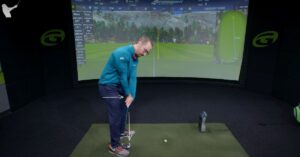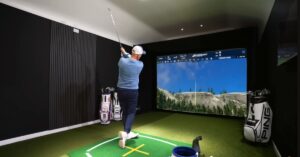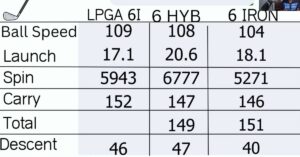Golf Draw Vs Fade: Understanding The Key Differences
Golfers who can shape their shots have a distinct advantage on the course, and two of the most common shot shapes are the draw and the fade. While they may seem similar, there are some key differences between the two.
The main difference between a golf draw and a golf fade is the direction of the ball flight. A draw curves from right-to-left (for right-handed golfers), while a fade curves from left-to-right.
In this article, we’ll compare golf draw and fade to help you understand when to use each one and how to execute them.
Golf Draw Vs Fade: What Are The Differences?
As a golfer, you may have heard the terms “draw” and “fade” used to describe different types of shots.
But what do these terms mean, and how do they differ from each other? Here, we will explore the differences between a draw and a fade in golf.
| Aspect | Draw | Fade |
| Ball Flight | Curves from right to left | Curves from left to right |
| Shot Shaping | Controlled right-to-left | Controlled left-to-right |
| Spin Direction | Backspin and sidespin | Backspin and sidespin |
| Club Face Orientation | Closed face at impact | Open face at impact |
| Swing Path | Inside-out | Outside-in |
| Ball Height | Slightly higher | Slightly lower |
| Strategic Use | Ideal for avoiding hazards on the right | Ideal for avoiding hazards on the left |
Ball Flight
The ball flight is the most noticeable difference between a draw and a fade in golf. When a golfer hits a draw shot, the ball starts its journey slightly to the right of the target (for right-handed players) and then gently curves back to the left, landing closer to the target.
On the other hand, a fade starts to the left of the target (for right-handed players) and curves gently back to the right, eventually reaching the intended target. So, a draw curves from right to left, while a fade curves from left to right.
Shot Shaping
Shot shaping refers to the ability of a golfer to control the direction in which the ball moves during its flight. For a draw shot, the golfer aims to hit the ball with a clubface that is slightly closed at impact.
This closed clubface encourages the ball to spin from right to left, producing the desired draw shape.
On the contrary, a fade requires the golfer to open the clubface slightly at impact. This open clubface imparts a left-to-right spin on the ball, resulting in the ball curving gently from left to right.
Spin Direction
Spin is a critical element in golf shots, and both draws and fades involve backspin, which helps the ball stay in the air longer and achieve greater distance.
In addition to backspin, both shot types also have sidespin, which affects the ball’s horizontal movement.
A draw generates sidespin that causes the ball to move from right to left, while a fade produces sidespin that makes the ball move from left to right.
Club Face Orientation
The clubface orientation at impact plays a significant role in determining the ball’s flight path.
To execute a draw, a golfer aligns the clubface slightly closed, meaning it points a bit to the left of the target for right-handed players. This closed clubface position helps initiate the right-to-left ball flight.
Conversely, for a fade, a golfer aims to have the clubface slightly open, pointing to the right of the target for right-handed players. The open clubface encourages the left-to-right movement of the ball.
Swing Path
The swing path refers to the direction in which the clubhead moves during the golf swing. To achieve a draw shot, a golfer uses an inside-out swing path.
This means that the clubhead approaches the ball from inside the target line, promoting the right-to-left spin and ball flight. In contrast, a fade shot requires an outside-in swing path.
Here, the clubhead approaches the ball from outside the target line, generating the left-to-right spin and shot shape.
Ball Height
The height of the ball’s flight is influenced by the shot type. Generally, a draw shot tends to have a slightly higher trajectory compared to a fade.
The higher ball flight of a draw can be advantageous in carrying hazards or obstacles on the course, allowing the ball to clear them more easily.
Strategic Use
Choosing between a draw and a fade strategically depends on the layout of the golf course and the obstacles or hazards present.
For instance, when there are hazards or trouble spots on the right side of the fairway, a draw can be used to navigate the ball safely to the left, avoiding potential dangers.
On the other hand, if there are obstacles on the left side, a fade can be employed to keep the ball on the right side of the fairway, away from trouble.
Golf Fade vs Golf Draw: What Are The Similarities?
As we explored in the previous post, a draw and a fade are two different types of golf shots that have distinct differences. However, there are also some similarities between the two shots.
Both Shots Utilize Spin
Both draw and fade shots involve adding sidespin to the ball. Sidespin is when the ball spins while it travels through the air. For a draw shot, the ball will have a clockwise sidespin (for a right-handed golfer), causing it to curve gently from right to left.
On the other hand, a fade shot has an anti-clockwise sidespin, making the ball curve slightly from left to right.
Understanding how to apply the right amount of spin is crucial for controlling the direction of the ball.
Aim Adjustment
When hitting a draw or fade shot, golfers need to adjust their aim to compensate for the spin.
For example, if a golfer wants to hit a draw, they will aim slightly to the right of the target (for a right-handed golfer), so when the ball curves to the left, it will end up closer to the intended target.
Similarly, when aiming for a fade, the golfer will align slightly to the left to account for the ball’s rightward curve.
Clubface Manipulation
The clubface angle at impact plays a crucial role in shaping draw and fade shots. To hit a draw, the golfer needs a slightly closed clubface, meaning the clubface is pointed more to the left of the target at impact.
In contrast, for a fade, the clubface is slightly open, pointing more to the right at impact. Skillfully controlling the clubface angle is vital for consistent shot shaping.
Ball Flight Control
Both draw and fade shots require practice and skill to control the ball’s flight path effectively. Golfers need to understand how to combine swing path and clubface angle to produce the desired amount of spin for each shot.
Consistent practice and a good understanding of ball flight laws help golfers develop the ability to hit draw and fade shots on demand.
Play With Wind
Knowing how to shape draw and fade shots allows golfers to adapt to varying wind conditions.
When facing a strong wind blowing from right to left, a draw can help counteract the wind’s force, while a fade can work well when the wind is blowing from left to right.
Being able to use these shots strategically can make a significant difference in a golfer’s performance.
Strategy Implementation
Being proficient in hitting draw and fade shots provides golfers with additional tools to navigate challenging courses.
For example, on a hole with a dogleg to the left, a draw shot can help position the ball nicely around the corner.
Conversely, on a hole with a dogleg to the right, a fade shot can keep the ball in play and avoid potential hazards.
Visual Cues
Observing the ball flight and paying attention to visual cues can help golfers understand the results of their shots.
Recognizing whether a shot ends up curving left or right can provide valuable feedback for making adjustments and improving shot consistency.
Golf Draw Vs. Fade: Which One Is Better?
The golf draw and fade are two different ball flight patterns that skilled golfers can intentionally produce.
A draw refers to a slight curve from right to left (for right-handed golfers), while a fade is a gentle curve from left to right.
Both shots have their advantages, and neither is inherently better than the other. The choice between a draw and fade depends on the golfer’s skill level, the specific shot requirements of a hole, and personal preference.
Some golfers may find draws more natural, while others prefer fades.
Ultimately, mastering both shots can provide greater versatility on the golf course, enhancing overall performance.
Frequently Asked Questions
If you’re a golfer, you’ve probably heard about draw and fade shots. Understanding the distinctions between these two ball flights can greatly improve your game. Here are the FAQs:
How Do You Hit a Draw?
To hit a draw, aim slightly right of the target, close the clubface, and swing with an in-to-out path. This generates the desired sidespin, causing the ball to curve.
How Do You Hit a Fade?
To hit a fade, aim slightly left of the target, keep the clubface slightly open, and swing with an out-to-in path. This imparts the needed sidespin for the ball to fade.
Which Shot Is Better, Draw, or Fade?
There’s no definitive answer. It depends on the situation and your playing style. Draw suits some players, while others prefer the fade. Experiment to see what works for you.
Can You Shape Both Shots on Command?
Yes, with practice, golfers can develop the ability to shape both draw and fade shots consistently. This skill adds versatility to your game, enabling you to tackle various challenges.
Are Draw and Hook the Same?
No, they are not the same. A draw is a controlled curve, while a hook is an excessive curve that might be unintentional and harder to control.
Are Fade and Slice the Same?
No, they are different as well. A fade is a controlled curve in one direction, whereas a slice is an excessive curve that tends to veer off the fairway and can be challenging to control.


![how many dimples are on a golf ball? [Science behind Dimples] how-many-dimples-are-on-a-golf-ball](https://giftedgolfers.com/wp-content/uploads/2023/01/how-many-dimples-are-on-a-golf-ball-300x157.jpg)



